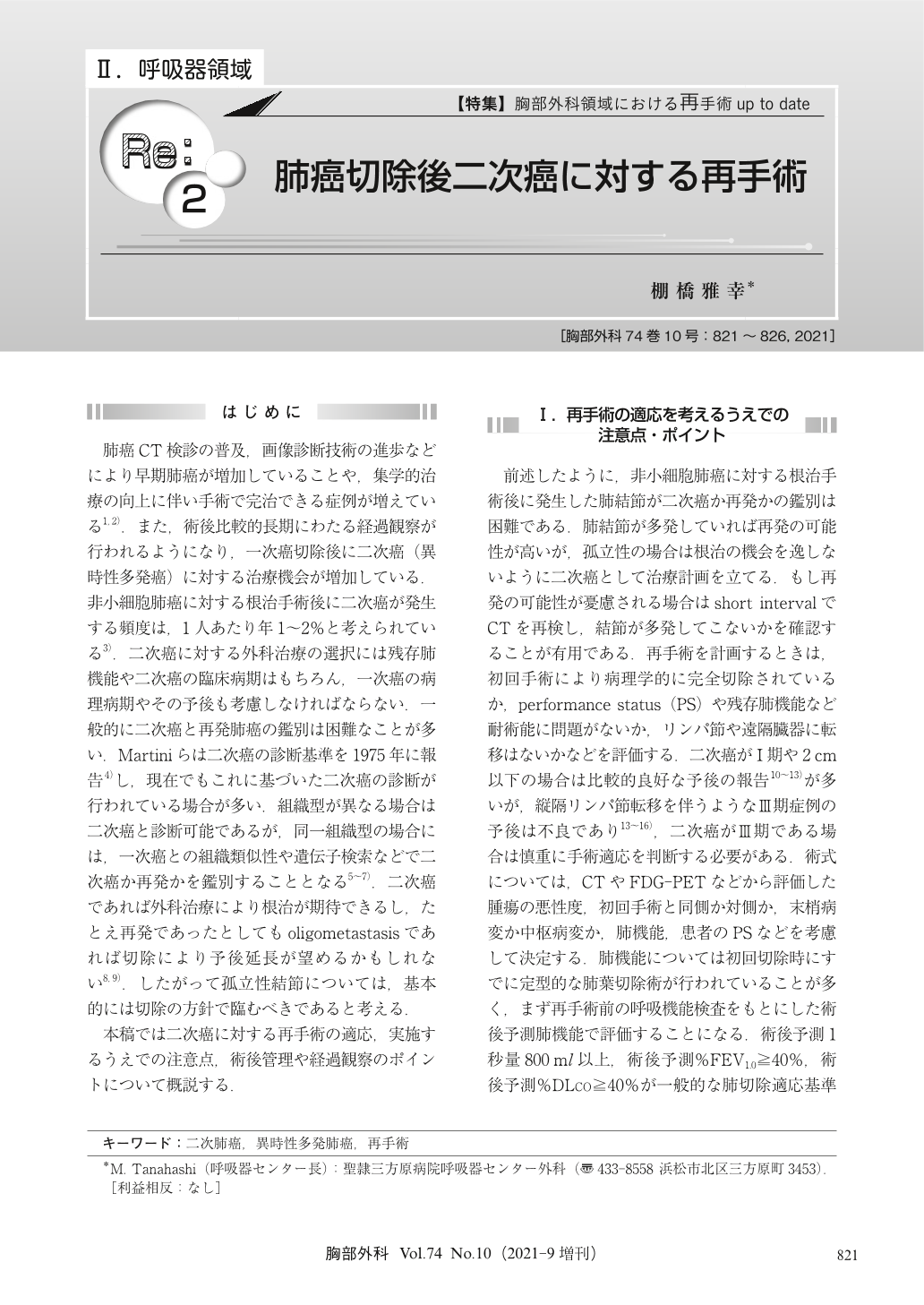Japanese
English
- 有料閲覧
- Abstract 文献概要
- 1ページ目 Look Inside
- 参考文献 Reference
肺癌CT検診の普及,画像診断技術の進歩などにより早期肺癌が増加していることや,集学的治療の向上に伴い手術で完治できる症例が増えている1,2).また,術後比較的長期にわたる経過観察が行われるようになり,一次癌切除後に二次癌(異時性多発癌)に対する治療機会が増加している.非小細胞肺癌に対する根治手術後に二次癌が発生する頻度は,1人あたり年1~2%と考えられている3).二次癌に対する外科治療の選択には残存肺機能や二次癌の臨床病期はもちろん,一次癌の病理病期やその予後も考慮しなければならない.一般的に二次癌と再発肺癌の鑑別は困難なことが多い.Martiniらは二次癌の診断基準を1975年に報告4)し,現在でもこれに基づいた二次癌の診断が行われている場合が多い.組織型が異なる場合は二次癌と診断可能であるが,同一組織型の場合には,一次癌との組織類似性や遺伝子検索などで二次癌か再発かを鑑別することとなる5~7).二次癌であれば外科治療により根治が期待できるし,たとえ再発であったとしてもoligometastasisであれば切除により予後延長が望めるかもしれない8,9).したがって孤立性結節については,基本的には切除の方針で臨むべきであると考える.
There has been an increase in cases in which complete recovery is possible through surgery thanks to improvements in multimodal therapy along with increased early-stage pulmonary cancer in conjunction with the spread of pulmonary cancer computed tomography (CT) examinations and advancements in image diagnostic technologies. Moreover, post-operative follow-ups are now conducted for a relatively longer period of time, so there are now more opportunities to treat secondary cancer. It is difficult to determine if nodules that occur following pulmonary cancer surgery are cases of secondary cancer or cases of relapse. In the case of a solitary nodule, it cannot be assumed that there has been a complete recovery from cancer, so reoperation should be actively considered. In the event of reoperation, not only should the expected post-operative pulmonary function be considered, but whether the location is the same lung or the other lung, the blood flow distribution of the remaining lung, as well as other factors, should also be considered. Reoperation on the same lung is extremely difficult because it assumes a high degree of accretion in the cavum thoracis. Even if reduction surgery or lobectomy of the remaining lung is planned, separation is difficult, with potential unforeseen conditions such as hemorrhaging. Therefore, this assumes unavoidable total extirpation of the remaining lung. Regarding reoperation on the other lung, attention must be paid to management of the respiratory system during surgery. Further, blood circulation relies on the lung in which the reoperation is to be performed more than expected, with cases existing in which complications such as pulmonary edema may occur due to a rapid reduction of the pulmonary vascular bed as a result of a pulmonary resection. In particular, attention must be paid to respiratory failure and heart failure in the event of a lobectomy in both lungs. Prior to surgery, it is beneficial to evaluate the blood distribution with a pulmonary blood flow scintigram. As suggested above, reoperation on secondary cancer following pulmonary cancer excision requires a detailed treatment plan before the operation.

© Nankodo Co., Ltd., 2021


